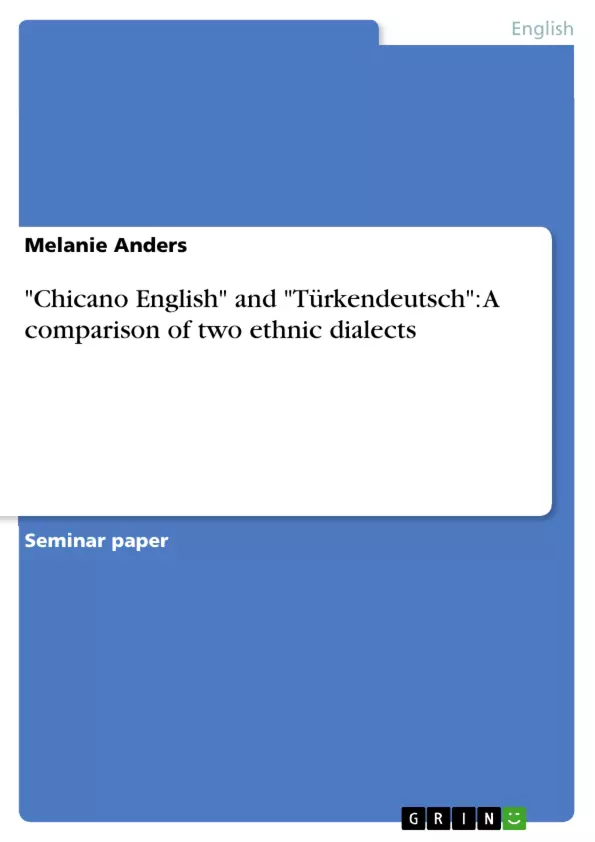"In every living language, processes of change are as inevitable as rain."
New dialects develop out of isolation as well as out of contact with other varieties. Thereby they are influenced by ongoing socio-cultural changes and, in turn, affect culture and way of speaking. This paper will summarize results of latest linguistic research on two ethnic dialects – Chicano English, a Hispanic variety of American English and Türkendeutsch , a relatively new variety of German. First, both varieties will be presented with regard to their history, their structural features and sociolinguistic aspects, starting with Chicano English. After outlining characteristics of both individually, major similarities and differences will be highlighted. Finally, difficulties in the context of this paper will be discussed and future prospects will be given.
Table of Contents
- 1 Introduction
- 2 Chicano English
- 2.1 The history of Chicano English
- 2.2 Structural features of Chicano English
- 2.2.1 Prosody and intonation
- 2.2.2 Phonology
- 2.2.3 Syntax and semantics
- 2.3 Sociolinguistic aspects of Chicano English
- 3 Türkendeutsch
- 3.1 The emergence of Türkendeutsch
- 3.2 Structural properties of Türkendeutsch
- 3.2.1 Phonology
- 3.2.2 Syntax and semantics
- 3.2.3 Features of stylized Türkendeutsch
- 3.3 Sociolinguistic aspects of Türkendeutsch
- 4 Similarities and differences
Objectives and Key Themes
This paper aims to compare and contrast two ethnic dialects: Chicano English and Türkendeutsch. The paper will examine the historical development, structural features, and sociolinguistic aspects of each dialect. The main objective is to highlight both similarities and differences between these varieties, providing insights into the processes of dialect formation and the impact of language contact. * Historical development of Chicano English and Türkendeutsch * Structural features of Chicano English and Türkendeutsch (phonology, syntax, semantics) * Sociolinguistic aspects of both dialects * Similarities and differences between the two dialects * Influence of language contact on dialect formationChapter Summaries
1 Introduction: This introductory chapter sets the stage for the comparative analysis of Chicano English and Türkendeutsch. It establishes the premise that language change is a natural and ongoing process, leading to the development of new dialects through both isolation and contact with other language varieties. The chapter introduces the two dialects as the main focus of the study, outlining the structure of the paper and highlighting its goals: to explore the history, structural features, and sociolinguistic aspects of each dialect, and ultimately to compare and contrast their characteristics.
2 Chicano English: This chapter provides a comprehensive overview of Chicano English (CE), challenging common misconceptions and defining it as a widespread Hispanic variety of American English spoken primarily in California and other southwestern US states. It emphasizes that CE is an independent dialect, not merely Spanish-accented English, with its own set of rules and patterns spoken across diverse age groups, social classes, and occupations. The chapter lays the groundwork for a deeper dive into its history, structure, and sociolinguistic context in subsequent sections.
3 Türkendeutsch: This chapter is dedicated to Türkendeutsch, providing a detailed examination of its emergence, structural properties, and sociolinguistic significance. Similar to the Chicano English chapter, it aims to establish Türkendeutsch as a distinct linguistic entity with its own unique characteristics. The chapter will cover the historical background of the dialect and investigate its phonological, syntactical, and semantic features, emphasizing how the dialect reflects cultural and linguistic interactions in a specific context.
Keywords
Chicano English, Türkendeutsch, ethnic dialects, language contact, sociolinguistics, phonology, syntax, semantics, language change, dialect variation, code-switching, language attitudes.
Frequently Asked Questions: A Comparative Analysis of Chicano English and Türkendeutsch
What is the main topic of this paper?
This paper provides a comparative analysis of two ethnic dialects: Chicano English and Türkendeutsch. It examines their historical development, structural features (phonology, syntax, semantics), and sociolinguistic aspects, highlighting both similarities and differences to understand dialect formation and the impact of language contact.
What dialects are compared in this study?
The study focuses on a comparative analysis of Chicano English (a variety of American English spoken primarily in the southwestern US) and Türkendeutsch (a German dialect spoken by Turkish communities).
What aspects of the dialects are examined?
The analysis covers several key aspects: the historical development of both dialects; their structural features, including phonology, syntax, and semantics; the sociolinguistic contexts in which they are used; and a comparison of their similarities and differences.
What are the key objectives of this research?
The main objective is to compare and contrast Chicano English and Türkendeutsch, providing insights into dialect formation processes and the influence of language contact. It aims to highlight both commonalities and unique characteristics of these linguistic varieties.
What are the key themes explored in the paper?
Key themes include the historical development of Chicano English and Türkendeutsch; the structural features of both dialects (phonology, syntax, semantics); sociolinguistic aspects of each dialect; a comparison of similarities and differences between the two dialects; and the influence of language contact on dialect formation.
What is included in the Table of Contents?
The table of contents includes an introduction, chapters dedicated to Chicano English (covering its history, structural features, and sociolinguistic aspects) and Türkendeutsch (similarly structured), and a concluding chapter comparing similarities and differences between the two dialects.
What are the chapter summaries?
The introduction sets the stage for the comparison, emphasizing language change and the development of new dialects. The Chicano English chapter provides a comprehensive overview, establishing it as an independent dialect. The Türkendeutsch chapter similarly presents it as a distinct linguistic entity. The paper concludes by comparing and contrasting the two dialects.
What are the keywords associated with this research?
Keywords include Chicano English, Türkendeutsch, ethnic dialects, language contact, sociolinguistics, phonology, syntax, semantics, language change, dialect variation, code-switching, and language attitudes.
What is the intended audience for this paper?
The intended audience is primarily academic, focusing on researchers and students interested in sociolinguistics, dialectology, and language contact.
- Citation du texte
- Melanie Anders (Auteur), 2012, "Chicano English" and "Türkendeutsch": A comparison of two ethnic dialects, Munich, GRIN Verlag, https://www.grin.com/document/208515



